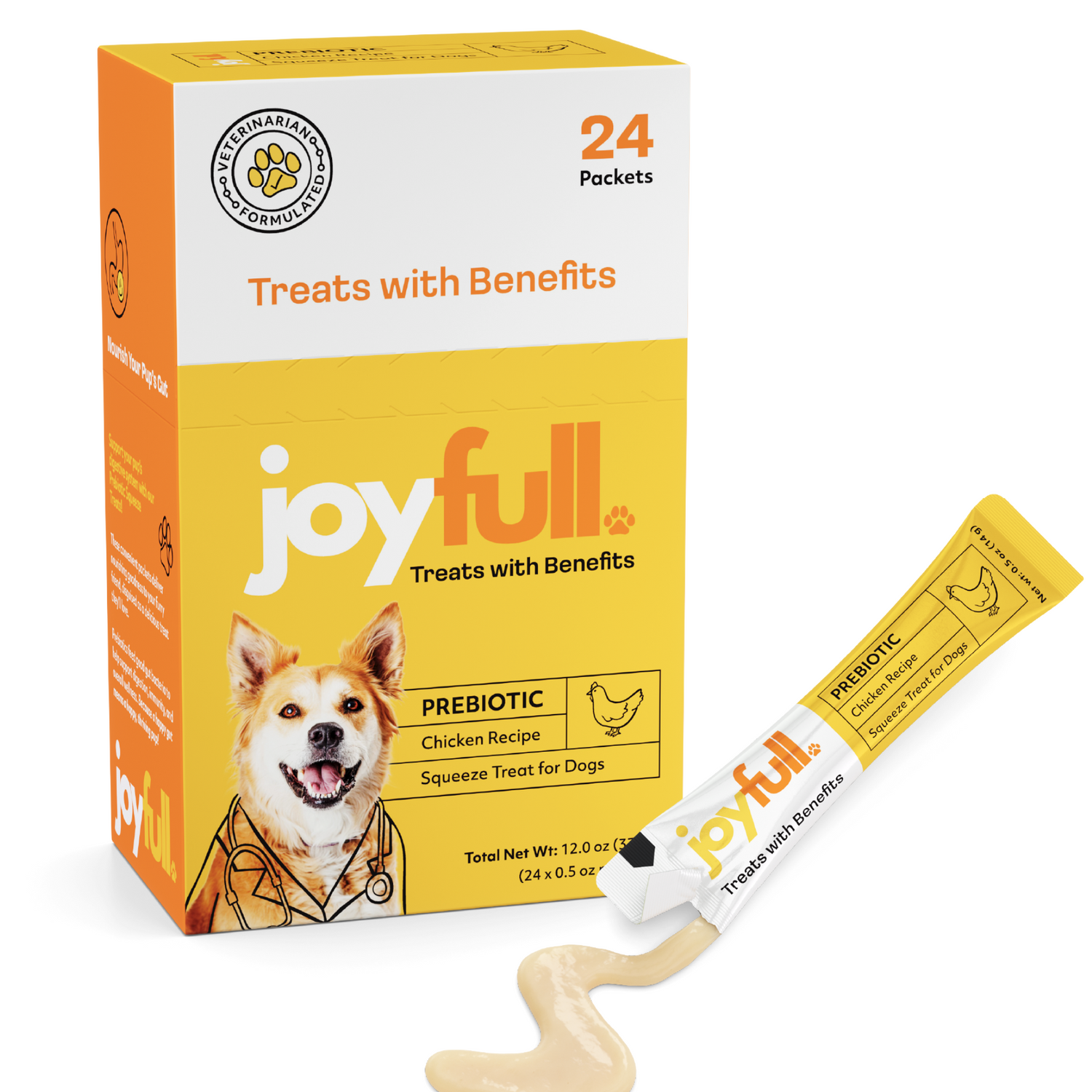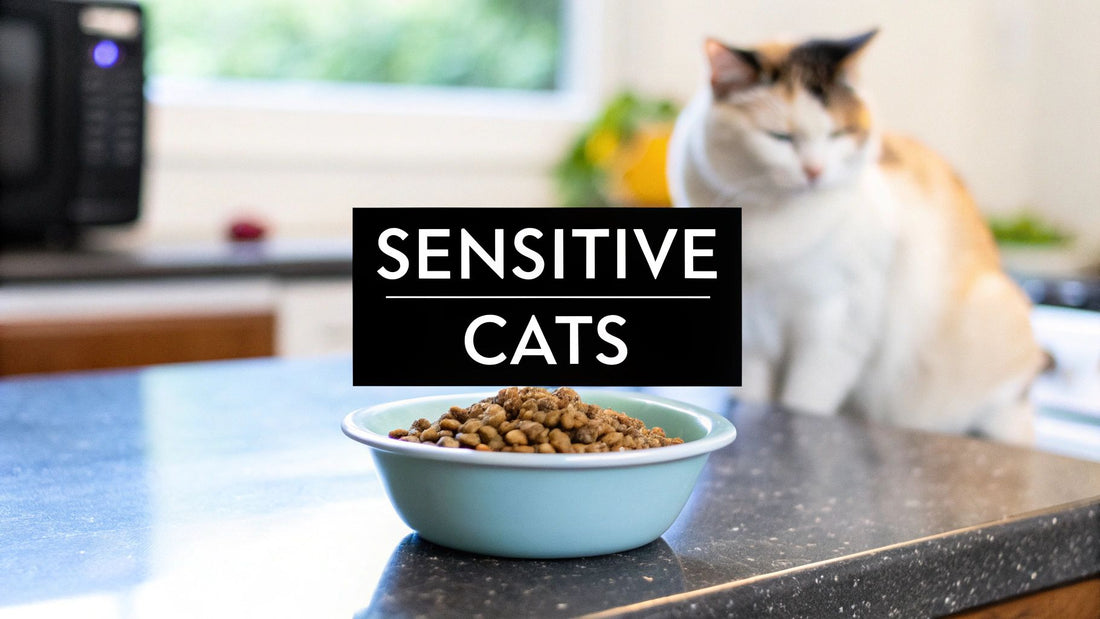
Best Limited Ingredient Cat Food for Sensitive Cats
The best limited ingredient cat food strips a recipe down to its essentials. It typically pairs a single, less common protein source—think duck or rabbit instead of chicken—with one easily digestible carbohydrate like sweet potato. The goal is to deliver high-quality nutrition with as few components as possible, making it easier to manage food sensitivities and calm a delicate digestive system.
Why a Simplified Diet Matters
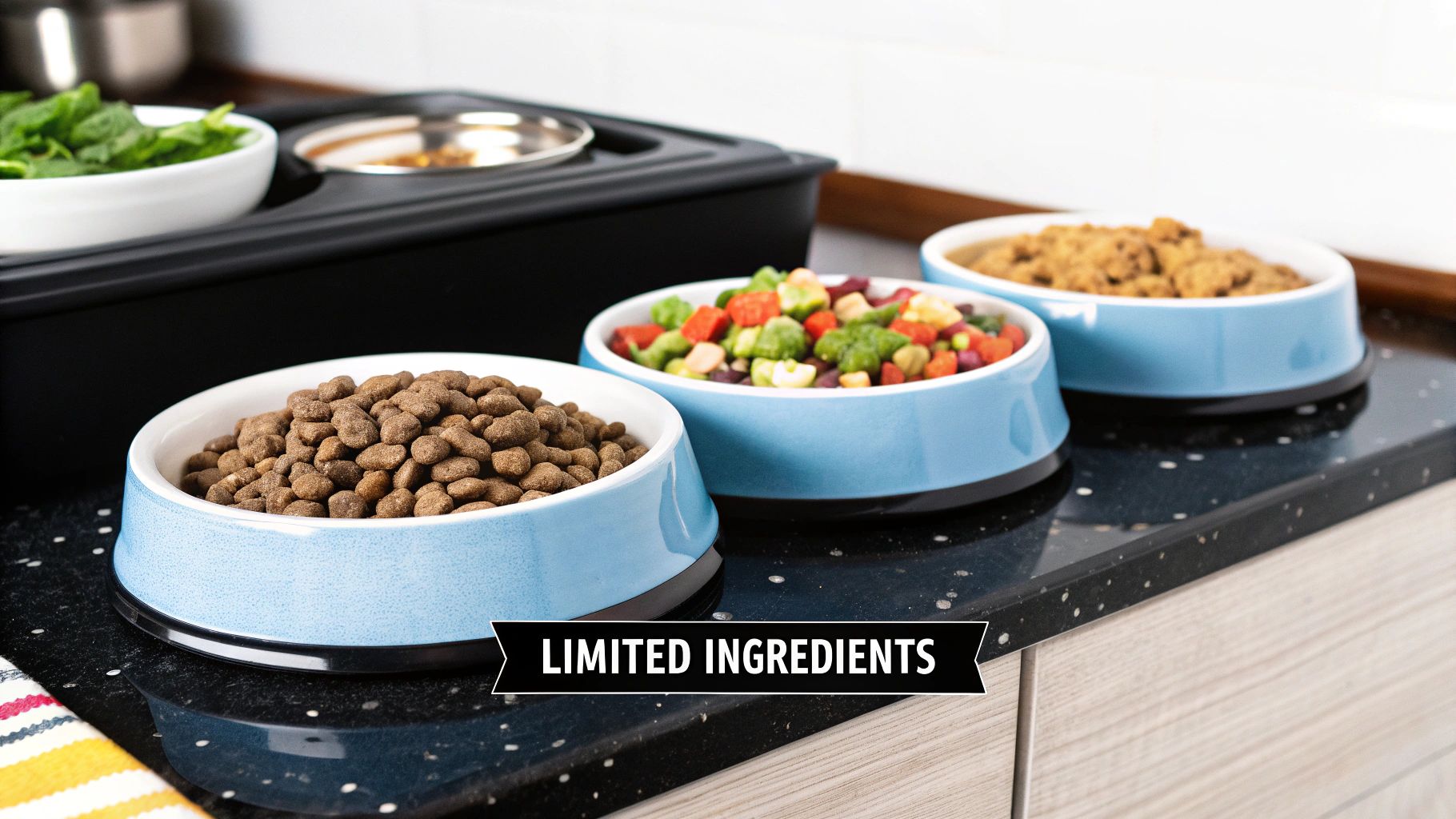
Staring at a wall of cat food options can be overwhelming, especially when you know your cat is dealing with itchy skin or an upset stomach. This is where Limited Ingredient Diets (LIDs) come in as a refreshingly simple solution. Think of an LID as a clean, minimalist meal plan for your cat, designed to take the guesswork out of feeding time.
Instead of a laundry list of ingredients, an LID gets back to basics. The philosophy is straightforward: the fewer ingredients your cat eats, the fewer potential triggers they're exposed to. This "less is more" approach is a game-changer for pinpointing and managing food sensitivities.
A true Limited Ingredient Diet isn't just about having a short ingredient list. It's a strategic tool for dietary investigation. By simplifying what's in the bowl, you create a clear baseline to figure out what truly helps your cat thrive versus what causes them problems.
This pared-down strategy is particularly helpful for cats that are constantly scratching, over-grooming, or experiencing chronic digestive upset. By isolating ingredients, it becomes much easier for you and your vet to connect the dots between what they're eating and how they're feeling.
To quickly see how these diets differ, let's compare them side-by-side.
Standard vs Limited Ingredient Cat Food At a Glance
| Feature | Standard Cat Food | Limited Ingredient Cat Food |
|---|---|---|
| Protein Sources | Often contains multiple proteins like chicken, beef, and fish in one formula. | Typically features a single novel protein (e.g., duck, venison, rabbit). |
| Carbohydrate Sources | May include several grains and starches like corn, wheat, soy, and rice. | Usually relies on a single, digestible carbohydrate like sweet potato or peas. |
| Ingredient List | Can be long and complex, with numerous additives, fillers, and flavorings. | Intentionally short and simple, focusing on core nutritional components. |
| Primary Purpose | General nutrition for the average, healthy cat. | Designed for cats with suspected food sensitivities, allergies, or intolerances. |
This table highlights the core difference: LIDs are purposefully simple to help you manage your cat's specific dietary needs, while standard foods are built for a broader audience.
Uncovering Food Allergies and Intolerances
It’s crucial to know the difference between a food allergy and an intolerance. An allergy is an immune system response to a protein, whereas an intolerance is a digestive problem. Their symptoms can look almost identical, which is why a controlled diet is so essential for a proper diagnosis. If you suspect an issue, learning about the common signs of food allergies in cats is a great starting point.
Veterinarians estimate that up to 10% of cats deal with these kinds of adverse food reactions. This has pushed manufacturers to create formulas that skip common triggers like chicken, beef, and dairy. In fact, the use of novel proteins such as duck and rabbit in cat food has jumped by over 40% since 2019, reflecting a major industry shift toward cleaner, more transparent recipes.
The Role of an Elimination Diet
Your veterinarian will likely recommend an LID as the foundation of an "elimination diet." This is the gold standard for diagnosing food sensitivities. The process involves feeding your cat a diet with only a novel protein (one they've never had) and a single carb source for about 8-12 weeks. If your cat's symptoms clear up, you've found strong evidence that a food ingredient was the problem.
This methodical approach helps you:
- Pinpoint specific triggers: After the initial trial period, you can slowly reintroduce old ingredients one by one. The one that causes a reaction is your culprit.
- Provide long-term relief: Once you know what to avoid, you can keep it out of your cat's diet for good, dramatically improving their comfort and quality of life.
- Simplify their nutrition: A successful elimination trial gives you a clear, confident path forward for what to feed your sensitive feline.
Choosing the best limited ingredient cat food is the critical first step in this whole process. It's what sets the stage for getting answers and helping your cat feel better for the long haul.
The Real-World Benefits of a Simplified Diet
Switching to a limited ingredient diet can do a lot more than just settle an occasional upset tummy. Think of it as a way to declutter your cat's nutrition. By stripping away all the extra noise—the fillers, common allergens, and jumbles of different proteins—you're giving their body a chance to run more peacefully and efficiently.
This straightforward approach gets right to the heart of some of the most frustrating issues cat owners face. It's surprising how many chronic problems, from constant scratching to a dull, lifeless coat, can be traced back to something in their food bowl. A clean, simple ingredient panel is often the key to providing relief.
This infographic lays out the core benefits you can expect from a simplified diet.
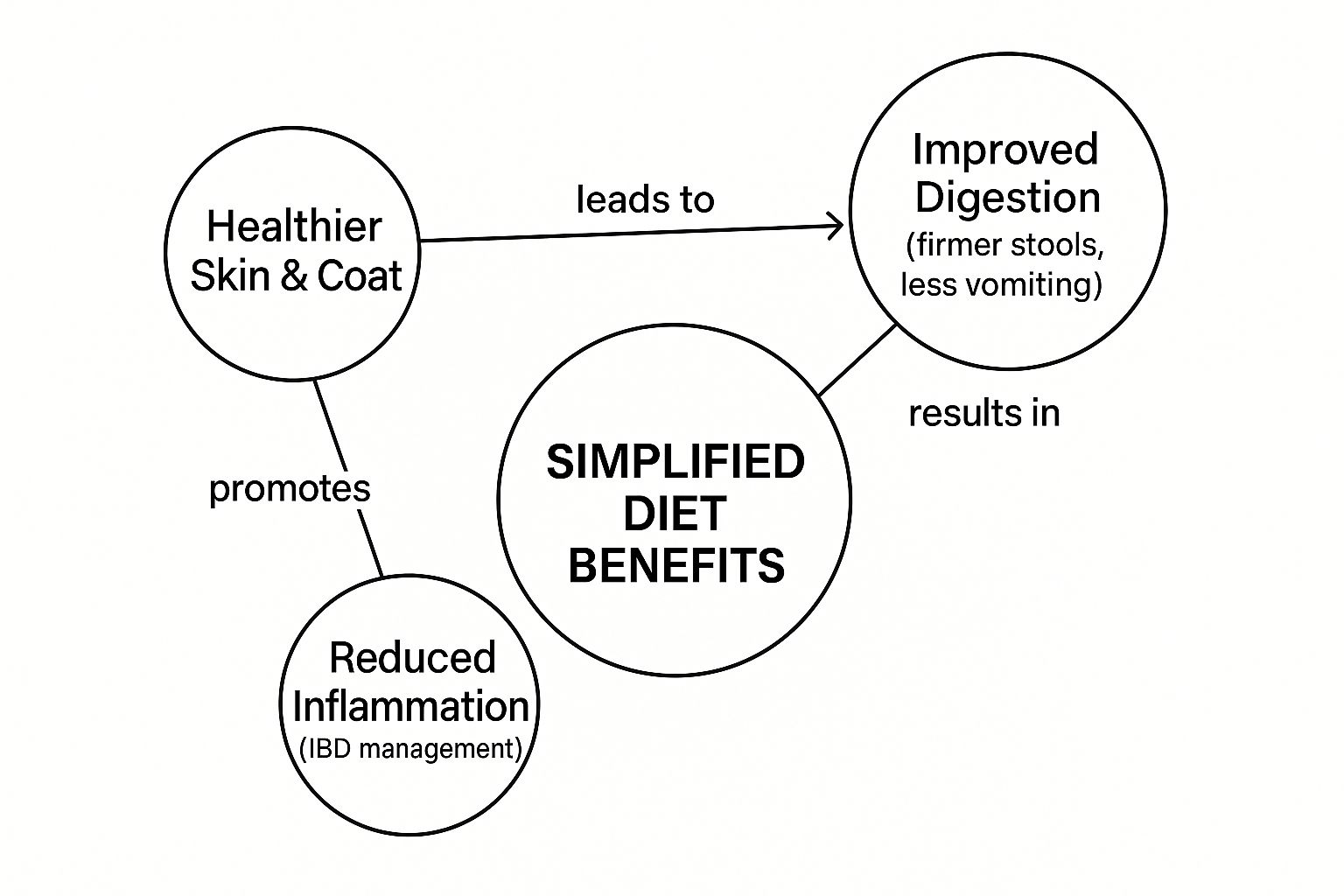
As you can see, the advantages are all connected. It usually starts with better digestion but quickly branches out to healthier skin and improved overall wellness.
Better Skin and a Glossier Coat
One of the first things you'll likely notice after switching to an LID is a major change in your cat's skin and coat. Food sensitivities often show up on the outside, causing relentless itching, hot spots, and dry, flaky skin. When you remove common culprits like chicken or beef, you dial back the inflammatory reaction causing all that misery.
Once the irritation calms down, your cat will scratch and over-groom less, giving their skin a chance to finally heal. The high-quality fats and single-source proteins found in a good LID provide exactly what their body needs to build a healthy, shiny coat that feels as good as it looks.
Calmer Digestion and Firmer Stools
Digestive trouble is, without a doubt, the number one reason people start looking into limited ingredient foods. A simple diet built around a single, easy-to-digest protein and carbohydrate is so much gentler on a cat's system. This almost always leads to a noticeable improvement in stool quality—think firmer, less frequent, and less smelly.
For cats who struggle with vomiting or diarrhea, this can be a game-changer. With less inflammation in the gut, they can absorb more nutrients from their food and have far fewer digestive flare-ups. It brings a level of comfort and predictability back to their daily life (and yours!).
A lot of serious digestive conditions, like Inflammatory Bowel Disease (IBD), are managed by trying to reduce inflammation in the intestines. An LID is a foundational part of that strategy because it minimizes the number of ingredients that could potentially trigger an immune response.
In the end, a simplified diet isn't about restriction; it's about being precise. By giving your cat a clean, targeted source of nutrition, you're helping their body heal and flourish from the inside out.
How to Read Cat Food Labels Like an Expert
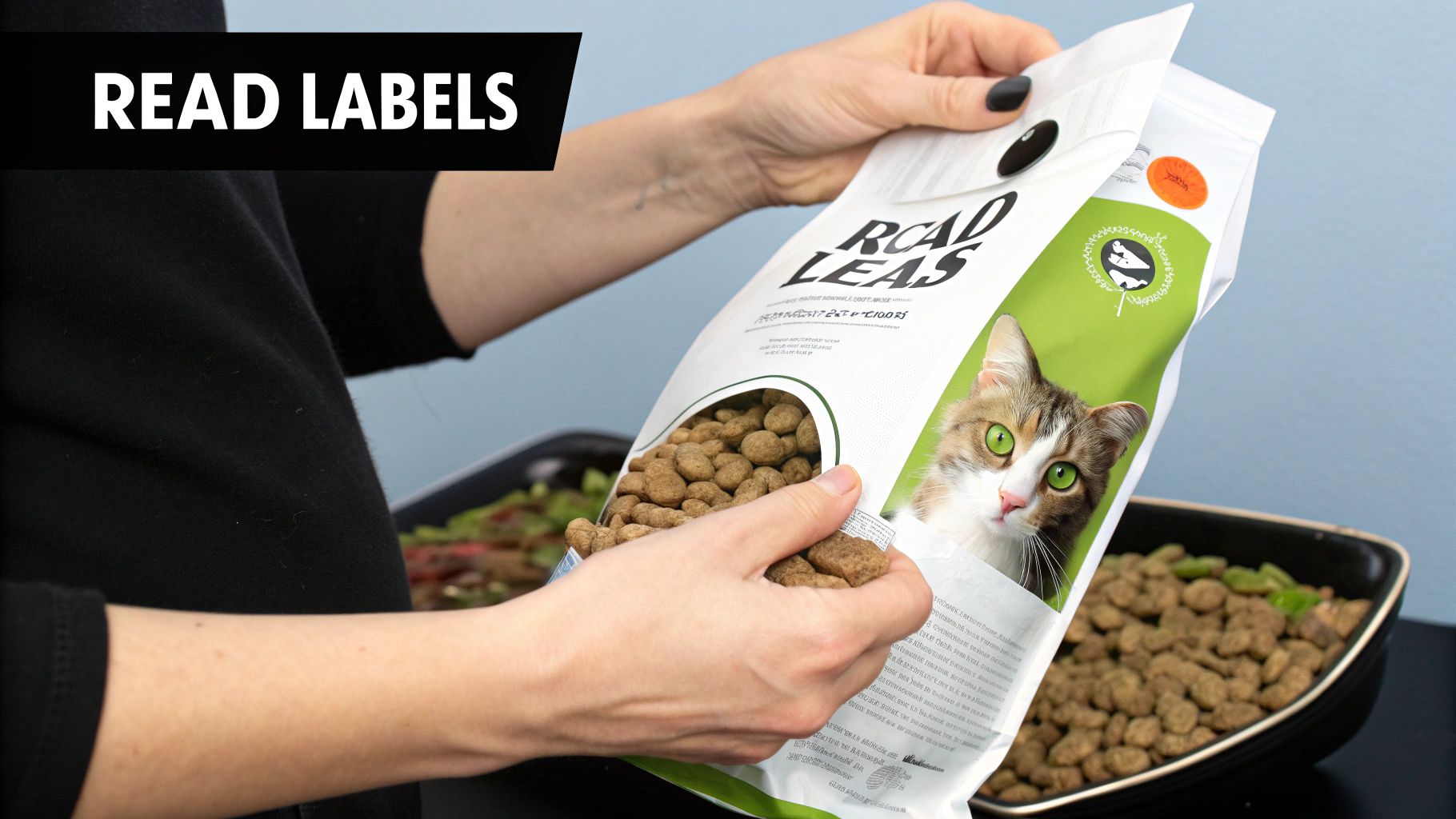
Ever feel like you need a secret decoder ring to understand a cat food label? That wall of tiny text can be intimidating, but learning to read it is the single most important skill for finding the best limited ingredient cat food. You're not just looking for pretty packaging; you're looking for the truth about what's inside.
The first rule of thumb is simple: ingredients are listed by weight, from most to least. That means the first few items on the list make up the majority of the food. For a genuine limited ingredient diet, you absolutely want to see a single, high-quality animal protein sitting right at the top.
Decoding the Ingredient List
Think of the first five ingredients as the main event. In a good limited ingredient food, this section should look clean and straightforward, with meat as the undeniable headliner. Pay close attention to how those ingredients are named.
Here’s what you want to see at the top of the list:
- A Single Novel Protein: Look for specific names like "Duck," "Rabbit," or "Venison." This should be the star of the show, not a mystery guest.
- A Single Digestible Carbohydrate: Ingredients like "Sweet Potato," "Green Peas," or "Pumpkin" are fantastic. They provide energy without relying on common allergens.
This "less is more" philosophy is the whole point. By keeping the ingredient list short and sweet, you eliminate the guesswork and make it far easier to pinpoint what works for your sensitive cat. For a more detailed look at picking the right food, our guide on how to choose cat food can help you navigate the aisles with confidence.
Understanding Protein Quality
Not all proteins are created equal, and the label gives you clues. "Duck" on a label, for instance, refers to the fresh meat, which naturally contains a lot of water. "Duck meal," however, is a concentrated protein source where most of the water and fat have been rendered out.
Don't let the word "meal" scare you off. While fresh meat sounds great, a high-quality, named "meal" can actually provide more concentrated protein. The key is specificity. "Chicken meal" is good; "meat meal" is a major red flag.
So what about "by-products"? This is a vague term for the leftover parts of an animal after the main cuts are taken. While some by-products can be nutritious, the term can also hide less desirable bits like feet or feathers. When you're dealing with a sensitive stomach, you want clarity, not mystery.
Spotting Hidden Fillers and Irritants
Once you've confirmed the protein and carb sources, it's time to play detective and look for unwanted extras. Fillers are cheap ingredients—often carbohydrates—used to bulk up the food without adding much real nutritional value. They can completely undermine the benefits of a limited ingredient diet.
Keep an eye out for these usual suspects:
- Corn and Soy: These are two of the most common feline allergens and offer very little nutritional upside for your obligate carnivore.
- Wheat Gluten: It's often used as a cheap protein substitute and is a well-known trigger for food sensitivities.
- Artificial Additives: If you see "artificial flavors," "colors," or chemical-sounding preservatives like BHA or BHT, put the bag back. They have no place in a clean, simple diet.
Learning to spot these red flags is empowering. It allows you to see past the marketing claims and choose a food that genuinely supports your cat's health.
Choosing the Right Ingredients for Your Cat
Grabbing a bag with a "limited ingredient" label is just the first step. The real magic—the thing that will actually help your cat feel better—is what’s inside that bag. Finding the best limited ingredient cat food means you have to become a bit of a detective, learning to spot the high-quality proteins, carbs, and fats that will soothe your cat's sensitive system.
Think of it like cooking for a friend with a food allergy. You wouldn't just throw anything in the pot; you'd carefully choose ingredients you know are safe for them. The same principle applies here. We're aiming for maximum nutrition with minimal risk of a flare-up.
The Power of Novel Proteins
At the heart of any great limited ingredient diet is the protein source. It’s the main event. Over time, many cats develop sensitivities to the proteins they eat every single day, like chicken, beef, and fish. It's almost like their immune system gets tired of seeing the same old thing and starts overreacting, which can lead to itchy skin, upset stomachs, and general misery.
This is where novel proteins come in to save the day. A novel protein is simply a protein your cat probably hasn't eaten before. Because their body has never encountered it, there's no pre-existing sensitivity, dramatically lowering the chance of an allergic reaction.
Some fantastic novel protein options include:
- Duck: Often a great choice for cats who react to chicken, duck is rich, tasty, and generally very well-tolerated.
- Rabbit: This one is a real winner because it’s so close to what a cat might eat in the wild, making it incredibly easy to digest.
- Venison: As a lean and gentle meat, venison is another excellent choice that you just don't find in most mainstream cat foods.
Switching to a food with one of these proteins is like hitting the reset button on your cat’s diet. It gives their overworked immune system a much-needed break from the usual suspects. You can dive deeper into this topic in our guide on the best ingredients for cat food.
Smart Carbohydrate and Fat Selection
Protein might be the star, but the supporting cast of carbohydrates and fats is just as important. A well-designed LID will stick to a single, high-quality carbohydrate source for energy. We're talking about whole foods like sweet potatoes, green peas, or pumpkin—not cheap fillers like corn or wheat that are common allergy triggers.
And don't forget the fats! Healthy fats are essential. Omega-3 and Omega-6 fatty acids are the superstars here, working to reduce inflammation, support healthy skin, and give your cat a shiny, beautiful coat. Look for ingredients like fish oil or flaxseed on the label to ensure your cat is getting these powerhouses.
A well-formulated limited ingredient diet is a masterclass in simplicity. It strategically combines a single novel protein, a single digestible carbohydrate, and healthy fats to create a complete nutritional profile that calms, nourishes, and heals.
Here's a quick look at some of the best ingredients you'll find in top-tier limited ingredient formulas.
Top Ingredient Choices for Limited Ingredient Diets
This table breaks down the types of high-quality, gentle ingredients you should be looking for when reading a cat food label.
| Ingredient Category | Excellent Choices | Primary Benefit |
|---|---|---|
| Novel Proteins | Duck, Rabbit, Venison, Lamb | Reduces the risk of allergic reactions by introducing a protein your cat's immune system hasn't encountered before. |
| Digestible Carbs | Sweet Potato, Pumpkin, Green Peas | Provides a steady source of energy without common allergens like corn, wheat, or soy that can cause digestive upset. |
| Healthy Fats | Salmon Oil, Flaxseed, Sunflower Oil | Delivers essential Omega-3 and Omega-6 fatty acids to fight inflammation, support skin health, and promote a glossy coat. |
Focusing on foods built with these components gives your sensitive cat the best possible chance at feeling their best.
The pet food industry is catching on, too. The use of alternative proteins—even things like insect meal—has jumped by 25–35% in premium cat foods since 2020 because of their hypoallergenic nature. It's also interesting to note that about 40% of new LID cat foods now include sustainability claims, a nod to pet parents who want formulas that are good for their cats and the planet. You can read more about this trend in the global cat food market report on researchandmarkets.com. This shift gives you more power than ever to find a food that works for your cat and aligns with your values.
How to Transition Your Cat to a New Food
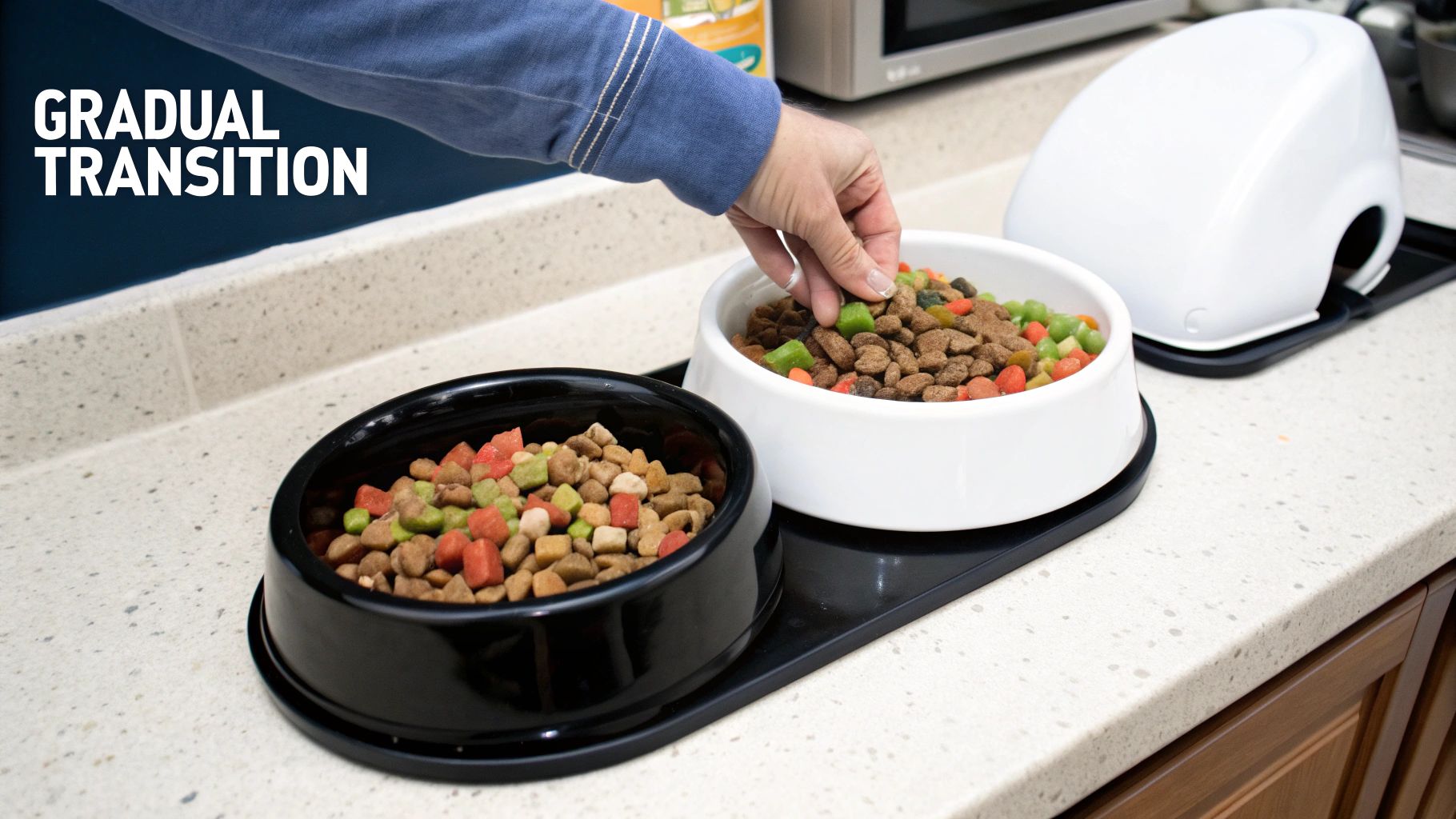
Cats are notoriously picky and, more importantly, creatures of habit. This extends right down to their digestive systems. If you suddenly swap their usual kibble for a brand-new limited ingredient diet, you're asking for trouble—often in the form of vomiting or diarrhea.
The key to a successful switch is patience. A slow, gradual transition gives their gut microbes time to adapt to the new ingredients. Think of it less like flipping a switch and more like slowly turning a dial. This process usually takes about 7 to 10 days, but if your cat is particularly sensitive, it's perfectly fine to stretch it out to two weeks.
The 7-Day Transition Schedule
Having a clear plan is the best way to keep things on track and your cat’s stomach happy. The goal here is simple: gradually increase the new food while phasing out the old. This lets your cat get used to the different tastes and textures without any abrupt surprises.
Here’s a tried-and-true schedule that works for most cats:
- Days 1-2: Start with a mix of just 25% new food and 75% old food. This is the "getting to know you" phase. Keep a close eye on your cat to make sure they're eating normally, and check the litter box for any signs of trouble.
- Days 3-4: If all is well, bump it up to a 50/50 split. By now, your cat should be getting more familiar with the new recipe.
- Days 5-6: Time to tip the scales. Change the ratio to 75% new food and only 25% of the old stuff. You're on the home stretch!
- Day 7 and Beyond: You've made it. You can now serve 100% of the new food. Your cat's system should be fully adjusted to their healthier, limited ingredient diet.
A quick but important tip: try to avoid giving your cat treats or table scraps during this transition week. If digestive upset occurs, you want to be certain it’s the new food and not a stray piece of cheese causing the problem.
Tips for Picky Eaters
But what if your cat takes one sniff and walks away? Some felines are just extra skeptical of change. If you're dealing with a particularly stubborn cat, don't lose hope. You just need a few more tricks up your sleeve.
- Warm It Up: If you're switching wet food, warming it slightly can enhance the aroma and make it far more enticing. A few seconds in the microwave is all it takes.
- Add a Topper: A tiny sprinkle of something they already love, like a few crumbs of freeze-dried chicken, can be just the encouragement they need to take that first bite.
- Go Slower: There's no prize for finishing in seven days. If your cat is hesitating, just extend each stage of the transition plan. Some cats need a couple of extra days at each ratio, and that's okay.
Following this gradual approach will make the move to the best limited ingredient cat food a positive experience for both you and your furry companion.
Answering Your Questions About Limited Ingredient Cat Food
Switching up your cat's food is a big deal, and it’s totally normal to have a ton of questions. You want to be sure you're doing what’s best for them. Let’s walk through some of the most common questions cat owners have when they start looking into the best limited ingredient cat food for their little buddy.
Diving into specialized diets can feel overwhelming, but it doesn't have to be. We'll get straight to the point and clear things up so you can understand if an LID is the right move, how it's different from other diets you see on the shelf, and what to expect along the way.
How Do I Know If My Cat Needs an LID?
So, when should you even consider a limited ingredient diet? It’s usually when your cat is dealing with stubborn signs of a food sensitivity. We're talking about things like non-stop itching, weird skin rashes, vomiting way too often, or diarrhea that just won't quit. When you've tried other things and these problems stick around, the culprit is often a common ingredient—usually a protein source like chicken or beef.
An LID cuts their meals down to the bare essentials, often just one protein and one carbohydrate source. This simple approach makes it much, much easier to figure out what’s causing the trouble. But first things first: always talk to your vet. They need to rule out other medical issues before you change their food. Your vet is your best partner in deciding if a food trial with an LID is the right call.
Are Grain-Free and Limited Ingredient Foods the Same?
This is a huge point of confusion for a lot of people. The short answer is no, they’re not the same because they’re designed to do different things.
- Grain-Free Food: This one is pretty straightforward—it just means the recipe contains no grains like corn, wheat, or soy. The catch is that it can still be packed with a long list of other ingredients, including several different proteins like chicken, turkey, and fish all mixed together.
- Limited Ingredient Food: The main goal here is to slash the total number of ingredients. It’s all about simplicity, sticking to a single animal protein and a single carbohydrate to lower the odds of a reaction.
The key takeaway is this: while many of the best limited ingredient cat food options happen to be grain-free, their core purpose is radical simplicity to manage sensitivities. A grain-free food is not automatically a limited ingredient one.
How Long Until I See Results on a New LID?
When you start an LID, patience is the name of the game. A proper food elimination trial isn’t a quick fix; it generally takes 8 to 12 weeks to really see if it's working and to give your cat's body enough time to calm down and heal from any inflammation.
You have to be strict during this trial. That means feeding only the new LID—no treats, no table scraps, and no flavored medications unless your vet gives the okay. You might see some digestive improvements, like better-looking stool, within a couple of weeks. But for skin problems like itching and rashes, you really need to give it the full 8-12 weeks. If things are looking good by the end of the trial, your vet will likely guide you on how to slowly reintroduce old ingredients one by one to finally nail down the specific trigger.
At Joyfull, we believe in simple, no-BS formulas. We build our recipes around clean, high-quality proteins to give your pet nutrition that truly makes a difference. Check out our approach to pet wellness and explore our recipes at https://joyfullpet.com.
